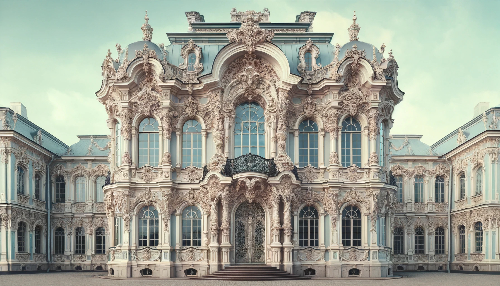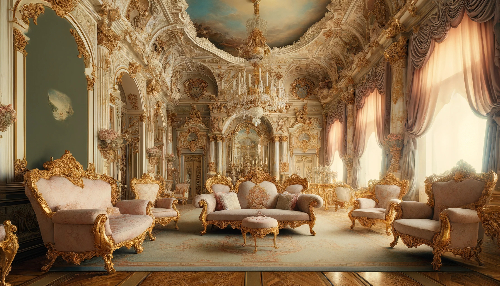The Rococo style, often considered an extension of the Baroque movement, is distinguished by its flamboyance and elegance. Born at the beginning of the eighteenth century, this artistic movement has been able to permeate various aspects of the decorative arts, from architecture to literature, painting and furniture. This article offers you a detailed dive into the fascinating world of Rococo, exploring its origins, evolutions, and lasting impact.
Origin and Definition of Rococo
Rococo takes its name from the French word "rocaille", which refers to the ornamentation of shells and rocailles. The term immediately evokes the extravagant aesthetic and curved lines that characterize this style. Rococo emerged in France during the reign of Louis XV, succeeding the more formal and imposing Baroque movement that dominated under Louis XIV. This style is marked by a lighter and more delicate approach, favoring light shades and sophisticated details.
The Rococo during the Reign of Louis XV
The reign of Louis XV was a fertile period for the development of the Rococo style. It was during this period that artists such as Jean Honoré Fragonard, François Boucher, and Jean Antoine Watteau flourished. Their works are distinguished by idyllic pastoral scenes and intimate compositions, often imbued with sensuality and frivolity.
Jean Honoré Fragonard and François Boucher
Fragonard and Boucher, emblematic figures of the Rococo, captured the essence of this style through their paintings. Their works are characterized by soft colors, subtle plays of light, and dynamic compositions. Pastoral scenes, often tinged with romanticism, are recurrent in their works, offering an idealized vision of aristocratic life.
Rococo Architecture

Rococo architecture is distinguished by its curved lines and elaborate ornamentation. Interiors are often decorated with frescoes, gilded stuccoes, and asymmetrical motifs. Architects such as Gilles Marie Oppenord and Nicolas Pineau were pioneers in the application of these architectural principles. Their creations are characterized by an unprecedented fluidity of form and decorative richness.
Aurèle Meissonnier and Rococo Architecture
Aurèle Meissonnier played a key role in the spread of Rococo architecture. His works are distinguished by a masterful use of floral motifs and arabesques, creating interior spaces that are both opulent and harmonious. The buildings of this period reflect a quest for lightness and movement, far from the massive structures of the Baroque.
Rococo Furniture

Rococo furniture is another expression of this lush style. Furniture, such as stylish armchairs, Rococo sofas, and Rococo chairs, are characterized by graceful shapes and abundant decoration. These pieces are often adorned with intricate carvings and precious fabrics, reflecting the refined art of living of the time.
Nicolas Pineau's Role in Rococo Furniture
Nicolas Pineau, cabinetmaker and architect, greatly influenced Rococo furniture. Her designs are distinguished by elegant curved lines and intricate rocaille patterns. The Rococo style in furniture is also known for its functionality and comfort, essential aspects for the aristocracy of the eighteenth century.
Influence of Rococo in the Decorative Arts
Rococo has left an indelible mark on the decorative arts. Objects such as porcelain, clocks, and mirrors have been made with particular attention to detail. The finesse of these pieces reflects the passion for aesthetics and meticulousness that characterized this period.
Jean Antoine Watteau and the Pastoral Scenes
Jean Antoine Watteau, with his pastoral scenes, captured the lightness and grace of the Rococo. His works often show fêtes galantes and bucolic landscapes, illustrating an idyllic and carefree life. This idealized representation of nature and society is a central feature of the Rococo.
Transition to Neoclassicism
Towards the end of the eighteenth century, Rococo gave way to neo-classicism. This new movement advocated a return to simplicity and the values of antiquity. The contrast between Rococo and Neo-Classicism is striking, marking an evolution in the artistic tastes and sensibilities of the time.
Neo-Classicism and the Decline of Rococo
Neo-classicism, with its admiration for classical forms and order, gradually supplanted Rococo. This transition reflects a reaction against the exuberance and excessive ornamentation of the Rococo, in favor of a more sober and rational aesthetic. However, Rococo continued to influence certain aspects of art and decoration, leaving a lasting legacy.
Modern Rococo
Today, Rococo continues to inspire designers and architects. The modern Rococo style often incorporates traditional elements with contemporary touches, creating spaces that are both elegant and functional. This modern reinterpretation of Rococo is a testament to the versatility and durability of this style.
Example of modern Rococo architecture
Modern Rococo architecture manifests itself in creations that blend Rococo ornaments with clean lines and modern materials. This merger creates spaces that honor the past while being resolutely forward-looking. Contemporary designers continue to explore this rich tradition, offering unique and innovative interpretations.
Conclusion
The Rococo style, with its curved lines, light hues and meticulous details, marked an era of refinement and beauty. From architecture to decorative arts, painting and furniture, Rococo has left an indelible mark on the history of art. Although supplanted by neo-classicism, its influence endures and continues to inspire today's designers. For those interested in learning more, there are many resources, such as books and articles, available, including the "The Rococo Style in Architecture PDF".


